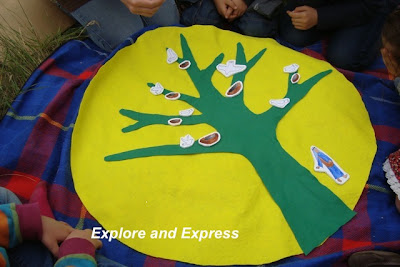Dear English-speaking readers, This post is a follow-up for my German-speaking readers to the last post about encouraging love and respect for the Bible among children. I also wanted to share what German language resources we used in our home and hear from them what they have used with their children.
Natürlich gibt es tausende Ressourcen über die Bibel in der deutschen Sprache sowie auf englisch. Soviel, dass man echt Schwierigkeiten haben kann, etwas auszusuchen ohne von der Auswahl überfordert zu werden. Hier möchte ich mit euch teilen, welche Bücher und Kinderbibeln wir in der Kinderkirche und in unserer Familie gelesen haben, und was wir davon hielten.
Als mein Sohn geboren wurde, schenkte ihm ein Pfarrerfreund Meine Erste Bibel: Geschichte von Jesus. Wir haben aber erst vorgelesen als er ungefähr drei war. Die Bilder sind zwar schön, aber ich hab's nicht gemocht, da es keine einzelnen Kapiteln gibt. Es ist eine einzelne lang laufende Geschichte und deshalb schwer einen Endpunkt zu finden um als Gute Nacht Geschichte zu lesen.
Als die Kinder ganz klein waren, haben wir keine gute Kinderbibeln für Kleinkinder gefunden. (Vielleicht könnt ihr ein paar empfehlen?) Sondern haben wir ganz viele Bücher über biblische Geschichten und Themen gehabt.
Z. B. dieses süße Buch über Psalm 23 mit einem Bären-Hirten. Jeder Vers des Psalmes ist illustriert und hat ein Gebet dazu.
Meine Kinder haben Jesus ist mein bester Freund: Was kleine Herzen wissen wollen besonders gemocht. In diesem Buch stellen Kinder sich vor, wie Jesus aussehen könnte, was er als Kind gemocht hat, usw.
Auch diese Serie von Parragon-Verlag über die berühmtesten Geschichten aus dem alten Testament haben wir gemocht. Die Bücher sind geeignet für Kinder 4-6 Jahre alt, obwohl drei-Jährigen die Bilder toll finden. Hier seht ihr Josef und seine Brüder.
Mit 5-6 Jahren haben wir diese Büchlein Serie, Was uns die Bibel erzählt entdeckt. Das sind kleine Büchlein, die hervorragend geschrieben und künstlerisch illustriert sind. Ich kann nur weiter empfehlen! Ich kaufe sie gern für die Kinderkirche, weil sie ein weiteres Angebot für die Kreativzeit nach einer Godly Play Geschichte sich gegeignen.
Ohne Frage ist dies die beste Kinderbibel, die ich entdeckt habe: Die Gott hat dich lieb Bibel. Sie ist auch von einem Kunstler illustriert (keine Comics) und der Text erzählt nicht nur die Geschichten, sondern den roten Pfad durch die ganze biblische Geschichten. Ich schenke diese Bibel oft und die Eltern lesen sie gern sowohl als auch die Kinder.
Neben Büchern haben wir die Musik von Daniel Kallach gern zugehört. Viele von den Texten in seinen Liedern kommen direkt aus der Bibel. Auch Bibel Hits: Du bist der Herr von Gerth Verlag.
Natürlich gibt es tausende Ressourcen über die Bibel in der deutschen Sprache sowie auf englisch. Soviel, dass man echt Schwierigkeiten haben kann, etwas auszusuchen ohne von der Auswahl überfordert zu werden. Hier möchte ich mit euch teilen, welche Bücher und Kinderbibeln wir in der Kinderkirche und in unserer Familie gelesen haben, und was wir davon hielten.
Als mein Sohn geboren wurde, schenkte ihm ein Pfarrerfreund Meine Erste Bibel: Geschichte von Jesus. Wir haben aber erst vorgelesen als er ungefähr drei war. Die Bilder sind zwar schön, aber ich hab's nicht gemocht, da es keine einzelnen Kapiteln gibt. Es ist eine einzelne lang laufende Geschichte und deshalb schwer einen Endpunkt zu finden um als Gute Nacht Geschichte zu lesen.
Als die Kinder ganz klein waren, haben wir keine gute Kinderbibeln für Kleinkinder gefunden. (Vielleicht könnt ihr ein paar empfehlen?) Sondern haben wir ganz viele Bücher über biblische Geschichten und Themen gehabt.
Z. B. dieses süße Buch über Psalm 23 mit einem Bären-Hirten. Jeder Vers des Psalmes ist illustriert und hat ein Gebet dazu.
Meine Kinder haben Jesus ist mein bester Freund: Was kleine Herzen wissen wollen besonders gemocht. In diesem Buch stellen Kinder sich vor, wie Jesus aussehen könnte, was er als Kind gemocht hat, usw.
Auch diese Serie von Parragon-Verlag über die berühmtesten Geschichten aus dem alten Testament haben wir gemocht. Die Bücher sind geeignet für Kinder 4-6 Jahre alt, obwohl drei-Jährigen die Bilder toll finden. Hier seht ihr Josef und seine Brüder.
Mit 5-6 Jahren haben wir diese Büchlein Serie, Was uns die Bibel erzählt entdeckt. Das sind kleine Büchlein, die hervorragend geschrieben und künstlerisch illustriert sind. Ich kann nur weiter empfehlen! Ich kaufe sie gern für die Kinderkirche, weil sie ein weiteres Angebot für die Kreativzeit nach einer Godly Play Geschichte sich gegeignen.
Ohne Frage ist dies die beste Kinderbibel, die ich entdeckt habe: Die Gott hat dich lieb Bibel. Sie ist auch von einem Kunstler illustriert (keine Comics) und der Text erzählt nicht nur die Geschichten, sondern den roten Pfad durch die ganze biblische Geschichten. Ich schenke diese Bibel oft und die Eltern lesen sie gern sowohl als auch die Kinder.
Neben Büchern haben wir die Musik von Daniel Kallach gern zugehört. Viele von den Texten in seinen Liedern kommen direkt aus der Bibel. Auch Bibel Hits: Du bist der Herr von Gerth Verlag.
Ich möchte sehr gern von euch hören, welche Kinderbibeln oder Geschichten ihr euren Kindern vorgelesen habt?





























![535686_10150932236814256_601874255_1[2] 535686_10150932236814256_601874255_1[2]](https://blogger.googleusercontent.com/img/b/R29vZ2xl/AVvXsEipxyx5VtCRCvg3tXqSt0IRu_yFKPd1vCHw_XV97YM_1Bijcw58_CsyZr7yvfFK4H-slLVUScRMRYJm749Wler2DA3ucuLk7UjttOvzw886VtJ6nCmcooj3NiO5PuhtRKmcq3_UhBiu56c/?imgmax=800)






